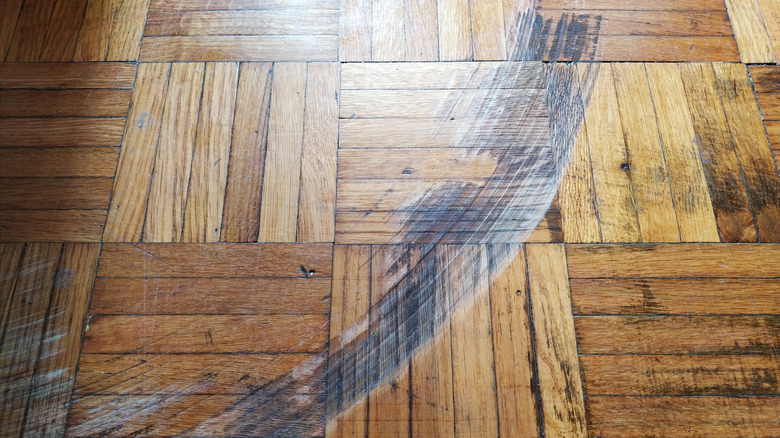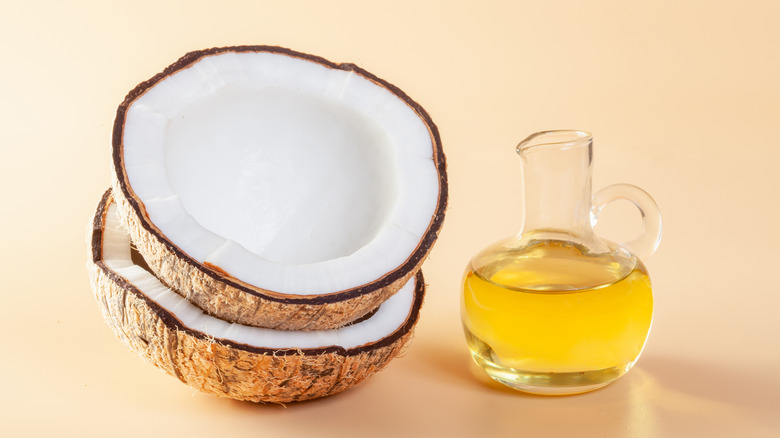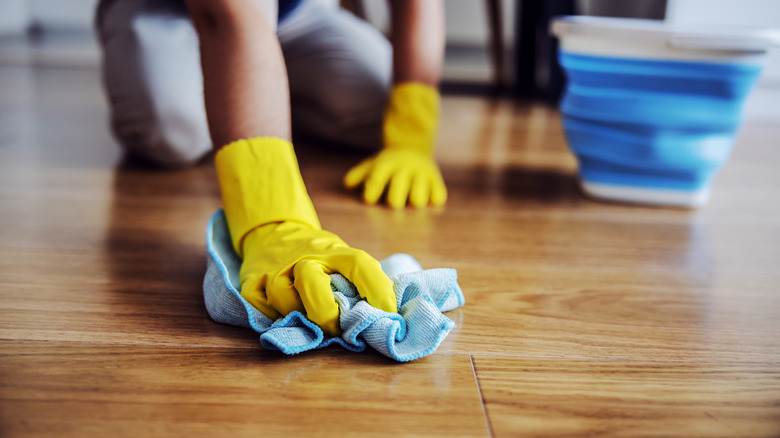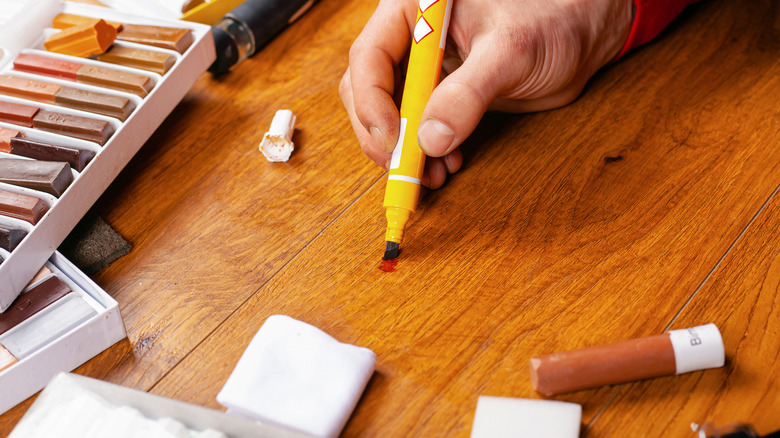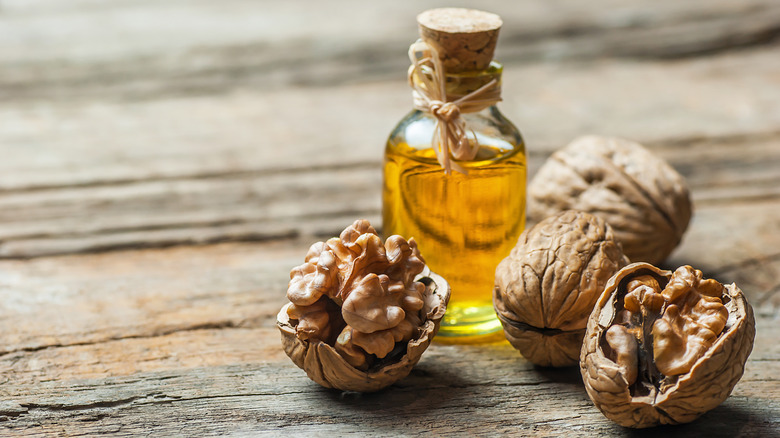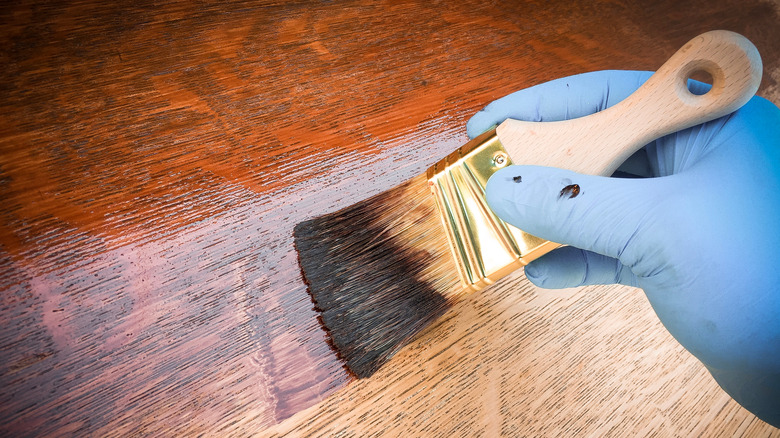Inexpensive Ways To Fix The Huge Scratch In Your Wood Floor
The average cost of new hardwood floor installation in 2020 ran between $7,200 and $14,400 — and that's only for a 1,200-square-foot home, according to HomeAdvisor. At such a steep price, any tiny scratch or scuff on the floor is bound to cause a bit of a panic. It's kind of hard to believe that we spend so much money on something that we just walk all over, but you have to admit: Nothing is quite as homey as a slightly creaky, perfectly glossy, happily lived-in hardwood floor.
But there's a difference between normal wear and tear and something a bit more dramatic. You might have kids playing on the floor with toy cars, dragging a surface scratch in their wake, or dogs running to greet you when you get home from work, leaving a gouge in the wood next to the doormat. Maybe it's the original wood that came with your new-to-you house, or maybe you splurged on a fancy finish when building out your dream home. Either way, the sheer stress of the simplest scratch in your wood floor is the same.
Before you reluctantly dip into your emergency fund to refinish your entire floor, we've rounded up a list of budget-friendly ways to fix the huge scratch in your wood floor. In the end, it'll look like nothing ever happened.
Start by raiding your pantry
We have some good news: You might be able to fix a run-of-the-mill scratch without even heading to your local hardware store. And, as a homeowner, you likely make enough trips to Lowe's as it is. So, if the scratch seems minimal, it's probably best to start with a homemade remedy.
Try making a solution of equal parts olive oil and apple cider vinegar, per Family Handyman. Dab it on the scratch, and let it sit; check back after a day, and wipe the mixture away. The scratch should now be unnoticeable. Note that this option works best for shallower scratches on new floors with a more recent finish.
No apple cider vinegar in the cabinet? BobVila.com recommends using a combination of baking soda and olive oil. Simply let it sit on the scratch for a few minutes, and then buff it into the wood. If your floors were unfinished or recently sanded down when they were scratched, opt for coconut oil instead. Either option should have your floors looking scratch-free and with an added bit of shine to boot.
Paste wax works wonders on scratches
For shallow surface scratches — like the kind that a dog or cat might leave behind on your floor — This Old House suggests a product like paste wax. There are even tinted options for darker floors, making everything look seamless and good as new.
All you have to do is let it dry, and then rub it into the floor so the scratch goes undetected. Just be warned: Paste wax is not recommended for polyurethane floors, so do your research and know what kind of floors you're working with before you go this route (via Jabara's).
You can grab a bucket of paste wax at your local hardware store to keep on hand for any additional problems. A one-pound bucket costs less than $7 at Home Depot, and there's enough to tackle any and all future scratches that may pop up — without breaking the bank.
Pick up a blending pen, pencil, or marker
Blending pencils, pens, or markers work like paste wax, but they can be a cheaper and more user-friendly option for scratch repair. It all depends on what's more suitable for your specific type of floor and finish. Polished Habitat said that Minwax stain markers were a lifesaver for her floors, and the difference is clear as day with just one swipe of the marker.
Another pro tip? Unlike paste wax, you can switch off between shades of stain with a pencil or marker, which allows you to accurately color match the grain in your floors. Polished Habitat used a darker marker for some spots and a lighter one for others, which elevated this DIY fix into professional-looking territory.
With a blending pen, pencil, or marker costing less than $15 on average, this solution is workable for any budget level, especially when compared to the cost of new or refinished floors.
Walnuts might save your wood floors
If you're rushing to remove a small scratch from older hardwood floors, you don't necessarily have to jump to the most expensive option and fully restore a small section. You might even have luck using the simplest hack of all, which could be in your kitchen pantry right now: walnuts.
BobVila.com explains that, since walnuts "contain excellent natural emollients and brown dyes," they act as a little-known solution for removing scuffs and scratches in your wood floors. Start by warming up the oil of the walnut with your fingers, and then slowly work it into the problem area of your floor. The process is similar to using coconut oil to repair a scratch. Let it sit for about five minutes, and then buff it away with a soft rag or cloth. If you're feeling particularly lazy, Wide Open Country also notes that you can crack open the walnut and rub it directly on the stubborn scratch for a quick fix.
Try refinishing small sections
If none of the above hacks have done the trick to remove the giant scratch on your wood floor, you might have to look into refinishing. Fortunately, that doesn't mean sanding everything down and starting over — chances are, you can get the job done on a much smaller scale.
According to Family Handyman, the first step in a case like this is to start with a finish restorer. If that fails, try to match the finish of your floor and give it a fresh coat instead. The same applies to a stained floor: Do your best to color match so that the edges of this new section blend in seamlessly with the rest. The new coat will cover the scratch without a hitch, but you want to be particularly careful to make sure it doesn't come across like a patch job.
Jabara's notes a few extra precautions to take, like using a scouring pad before going in with the finish to buff out any raised edges left behind by the scratch. Once that's done, fill in any gouges with wood filler or putty, and then give it a light sanding. While this is one of the trickier items on the list — and costlier, given the price of a new finish — it's certainly worth a shot if it saves your prized hardwood floors.
And, if all this seems like a headache you want to avoid entirely, you might want to consider laminate flooring in the future.
